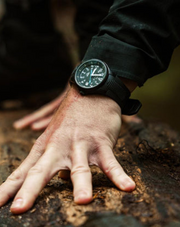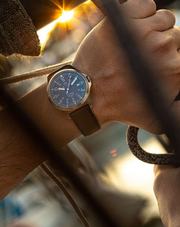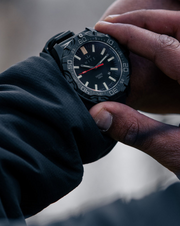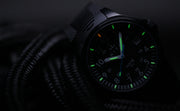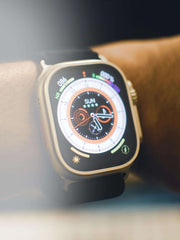Key Takeaways
- T100 tritium is roughly four times brighter than T25, crucial for challenging conditions
- T25 contains up to 25 millicuries whilst T100 ranges from 25-100 millicuries of tritium gas
- Both provide up to 20 years of continuous illumination with identical lifespans
- Tactical operations often prefer T25, whilst divers benefit from T100 brightness
- Both meet identical safety standards for daily wear
What These Numbers Actually Mean
When comparing T25 vs T100 tritium watches, the key difference is brightness: T100 produces roughly four times more light than T25. These numbers tell you exactly how much tritium gas is packed into all the glowing parts of your watch. T25 tritium watches contain up to 25 units, whilst T100 models pack between 25-100 units.
More tritium means more light when you need to check the time in complete darkness. It's as simple as that. Unlike luminous paint that needs charging and fades within hours, both T25 and T100 keep glowing consistently for decades.
The Swiss make these precision glass tubes filled with tritium gas, and they're built to last. No batteries, no charging, no fading overnight when you actually need to see what time it is.
The Brightness Difference You'll Actually Notice
T100 tritium puts out roughly four times more light than T25. Put them side by side and you'll see the difference straight away. This matters when you're underwater where visibility drops fast, or when you need to read time quickly in tactical situations.
Green tritium gives the brightest glow, which is why most professional kit uses this colour. White manages about 60-95% of green's brightness, orange hits roughly 50%, and ice blue achieves 40%.
Both specs handle extreme temperatures from Arctic cold to desert heat without issues. The energy output stays extremely low and can't penetrate skin, so there are no health concerns with either specification.
Where Each Specification Works Best
Military units pick specifications based on what they actually need in the field. Special Forces often go for T25 because it gives essential visibility without creating light signatures that might give away positions. The controlled brightness works perfectly for operations where you need to stay hidden.
Professional divers, emergency responders, and aircrew benefit from T100's brighter glow when quick time reading becomes critical for safety. The Canadian Armed Forces specifically chose tritium for their Search and Rescue operations because it works when everything else fails.
Industrial applications split differently too. Offshore workers on night shifts want T100 visibility for safety timing, whilst security personnel might choose T25 to keep a lower profile during patrols. Each job has specific needs that determine which spec makes sense.
Safety and Travel Considerations
Both T25 and T100 meet the same safety standards. The tritium stays sealed inside glass tubes, and the low-energy radiation can't get through skin. You can wear either specification daily without any precautions needed.
Different countries have varying rules about tritium imports though. The US allows tritium watches without licensing, whilst European countries generally permit sales with some variations. Italy has stricter controls requiring import permissions.
T100 watches might get extra attention during international travel because of the higher tritium content, but levels stay well below anything that causes concern. Check destination regulations before travelling internationally to avoid customs hassles.
Brand Quality and What to Expect
NITE Watches makes the distinction clear between their T25 MX10 series for tactical use and both T25 and T100 options available in their Alpha and Hawk collections. This straightforward approach helps you pick the right spec for what you actually need.
The same Swiss company supplies tritium tubes to virtually all quality brands, so performance stays consistent. But tube placement, case design, and crystal quality affect how well you can actually see the glow and how long it lasts.
Quality manufacturers back their watches with proper service networks and guarantee tritium replacement throughout the watch's life. This support matters when you depend on your timepiece for critical applications.
Environmental Performance
The construction handles serious conditions including shock, temperature extremes, and water immersion. Both T25 and T100 maintain the same performance standards regardless of brightness levels.
Professional users report excellent long-term reliability with both specifications. Military units document decades of service without tube failures, whilst diving operations report consistent performance through thousands of cycles.
The construction stays reliable through mechanical stress that can affect electronic alternatives. Operations involving vibration from helicopters and industrial environments don't impact tritium performance.
Which One Should You Choose
In practice, most professional applications find T25 provides adequate visibility for essential timekeeping. Specialised roles that justify T100's brighter performance tend to be specific situations like deep diving, underground work, or extended night operations.
Consider your actual working environment. If you're doing general outdoor activities or tactical work, T25's balanced performance and easier regulatory acceptance might make more sense. Underground ops, professional diving, or extended night work favour T100 brightness.
Understanding tritium technology helps you match tritium watches to real needs rather than just assuming brighter equals better. For more detailed guidance on choosing the right watch for your specific needs, talk to experienced users in your field who've actually used both specs operationally.
Ready to find your perfect tritium watch? Browse our complete collection to compare T25 and T100 options across our Alpha, Hawk, and MX10 ranges.
Frequently Asked Questions
How much brighter is T100 compared to T25? T100 produces roughly four times more light than T25. The difference is immediately obvious when you compare them and becomes crucial in challenging conditions like underwater or complete darkness.
Are either of these specifications dangerous to wear? Both T25 and T100 meet identical safety standards. The low-energy radiation can't penetrate skin, and the tritium stays sealed in glass tubes. No special precautions needed for daily wear.
How long does the glow last? Both specifications provide up to 20 years of illumination with optimal brightness for the first 8-10 years. After 12.3 years, brightness drops to about half but remains visible in darkness.
Which specification do military units prefer? It depends on the application. Special Forces often choose T25 for tactical operations where controlled brightness matters. Support roles and emergency services might prefer T100 for maximum visibility.




